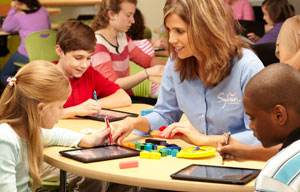Information Literacy And Critical Thinking Skills
Research: Developing information literacy and critical thinking skills: An experience of practicing flipped classroom strategy
In this study lessons were designed to mimic the rationale of flipped classrooms and 107 students participated from two secondary schools. This was a 13-week study creating digital classrooms where students could get support to develop their broad and deep understanding of a subject while also working on critical thinking skills.
The ways the study suggested developing deep learning and the ways it addressed critical thinking are worth pursuing by teaches and school systems.
First students engaged in pre-lesson mind mapping tasks on shared Tablet PCs, and they had two target subjects they worked with for critical thinking. Then they had face-to-face interactions with other students to learn more in-depth about a certain subject in class. This was all followed by online sharing and discussion to consolidate their thoughts after the lessons.
Students showed significant growth in learning a great deal about focused subjects, and also in the five major areas of their critical thinking skills.
For this study the teachers and the researchers worked together to design the pre-class materials. This echoed good relationships between teachers, and their best practices. Sustaining reciprocal and beneficial relationships in sharing these resources would be helpful to implementing flipped classroom changes.
But actually engaging teachers in such reflective and collegial practices long term needs more research, and professional development in the areas of soft skills could help.
- Teachers in the study recognized they would do well to focus less on class discipline during the flipped classroom longer discussion sessions, focusing on encouraging students to speak up and participate instead.
This professional development would go beyond learning to design suitable task progressions that consistently integrate both types of learning.
- Teachers need to feel and actually be more competent in digital classroom practices that combine both information literacy and critical thinking.
The concept of providing sufficient time for student discussion didn’t impact those students who tended to keep quiet during periods when all were welcome to share ideas with the group.
Here’s major feedback from the study:
- In terms of the way things were done, students appreciated the sequence of the learning tasks given to them, as well as the way guidance was adopted as a means of moving through the open discussion portion.
- Teachers indicated their students needed more time to properly discuss problem solving tasks and that they also needed more guidance for the thinking exercises.
- Students also were pleased with having been provided enough time to do their tasks and the hints that were given as they worked on interpreting questions.
- Students liked the incentives to peer discussion.
- Both the teachers and the students thought they were very successful in the way there was guidance as a feature of the students’ group sharing, particularly around the development of critical thinking skills.
In conclusion, both students and teachers believe that trial teaching should promote the gradual mastery of critical thinking skills, such as performing a stepwise process. Improved teacher soft skills during extended open discussion time would be useful to a range of students. And both teachers and students agree that the ways in which critical thinking were developed in this study are worth implementing on a regular basis.
Kong, S. C. (2014). Developing information literacy and critical thinking skills through domain knowledge learning in digital classrooms: An experience of practicing flipped classroom strategy. Computers & Education, 78, 160-173.
